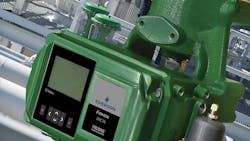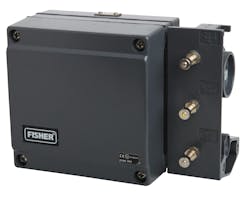Evaluating digital valve controller options
As automation advanced into the 1970s, it became clear that control valves were a weak link in the process. A setpoint signal was sent to a valve, but variable air supply pressures, pneumatic leaks and changing process conditions often kept the valve from reaching and holding the target. To address this shortfall, the electro-pneumatic positioner was introduced in the 1970s, and it took an electrical setpoint from the control system and adjusted the pressure as necessary to match the actual valve position to the desired value.
Over the decades, the electro-pneumatic positioner evolved into a much more capable digital valve controller with the introduction of microprocessors. With each generation of equipment upgrades, digital valve controllers incorporated new and better sensors and utilized improved diagnostics. Unfortunately, those features also made the equipment more complicated to configure and troubleshoot.
A new generation of digital valve controllers are entering the market to address these and other issues. This article discusses the latest generation of digital valve controllers, and it suggests the features end users should evaluate when choosing replacements or new equipment.
Valve positioning through the years
Electro-pneumatic positioners have come a long way since their humble roots 50 years ago. At that time, the lack of tight control made fast and accurate process control very difficult. While several issues were to blame, a significant problem was created by the inconsistent response of the valve itself.
Depending on the pressure drop across the valve, as well as the instrument air pressure and valve dead band, the valve position deviated from the commanded position, and that difference was constantly changing. This tended to move the process away from setpoint and kept control of the valve in a constant state of flux.
In response, a local electro-pneumatic controller, often referred to as a valve positioner, was developed for mounting the valve (Figure 1). The positioner measured the actual valve position via a mechanical linkage, and then adjusted the actuator pressure as required to drive the valve position to match the command from the control system. The positioner largely eliminated the deviations created by the control valve itself, improving overall process control dramatically.
These early valve controllers were ultimately upgraded to fully digital valve controllers in the 1990s. Full digitalization allowed faster control and easier configuration. Subsequent improvements incorporated an increasing number of sensors to measure air pressure, air flow, stem velocity and other parameters. The troublesome mechanical linkages were eliminated around 2004, and the devices started incorporating modular components for ease of maintenance. All these changes greatly improved the long-term performance and reliability of digital controllers.
Manufacturers then turned their attention to software improvements, with a goal of utilizing the sensors and valve position information to detect developing control valve problems, and to alert plant personnel before control performance degraded significantly. Digital valve controllers had now become a continuous source of data, which could be mined and acted upon to maximize uptime and avoid unplanned shutdowns. These new capabilities were certainly welcomed, but they did come at a cost.
Configuration of the digital valve controller became more complicated. More importantly, the controller itself remained nothing more than a pass-through transmitter of information. As long as valve monitoring software, typically installed in a control room or other location remote from the valve, was continually polling the valve controller for information and storing it, this approach worked well. However, if that communication was not continuous, or if the polling software was not available, the control valve data was lost.
Further advances in digital valve controllers addressed this and other issues, as explained further.
Valve controller processing power
The exponential increase in chip processing power has allowed manufacturers to significantly upgrade the computing capability and data storage of digital valve controllers, providing many benefits.
One simple yet very useful capability is the ability to handle a multitude of languages (Figure 2). This allows a single digital valve controller to be installed in countries all over the world. For large international companies, this feature can be particularly useful.
Configuration of the device also became quite easy as advanced computing was brought to bear. Calibration of the positioner used to be a very involved procedure, requiring specialized knowledge, time and patience. By contrast, users now simply initiate an automatic calibration sequence and answer a few questions on the interactive local display, and the digital controller does the rest.
Another immediate benefit is the ability to store data. Before, the digital valve controller had the sensors to gather data, but if that data was not immediately transmitted, it was lost. Now the digital valve controller can continually capture and store data, so when an event happens, the controller can save the data before, during and after the event. It also has the capacity to store hundreds of such events, so the technician can evaluate that information days, weeks or even months later.
This combination of extensive memory and processing power allows the digital valve controller to not only capture information but analyze it. Instead of simply flashing an alert that there is a problem, the latest generation of digital valve controllers can apply data analytics and deduce what the problem is, and then offer solutions to resolve it, right at the device. Such power is extremely useful in the field when a technician is looking to identify and correct the problem as quickly as possible.
Valve controller features worth pursuing
When considering valve controllers for the next project or upgrade, end users should demand specific features to realize significant improvements in valve operation and service life.
- Ease of use at the device — Digital valve controllers should have simple buttons and an integral display, empowering technicians to immediately see the status of the device, navigate simple menus, perform configuration and conduct troubleshooting. These buttons should be readily accessible during operation, even in plant areas classified as hazardous.
- Ease of configuration — Device setup should be largely automatic and require only answering a few questions. The controller should be able to be configured and calibrated with very little input from a technician.
- Advanced sensing — Instrument air flow and pressure, along with various temperature and velocity sensors, are needed because they allow the controller to not only control valve position, but to also sense conditions that cause performance to degrade. This might include instrument air pressure issues, sticky packing, high/low temperature, excessive valve cycling, diaphragm leaks, electrical signal failures and other problematic conditions.
- Data Storage — Any new controller should be able to detect a valve performance event, and capture and store data before, during and after the event for future review. Ideally, the digital valve controller should be able to store hundreds of such events.
- Data analytics — Sensing and storing data is important, but that information has little value if it provides no actionable direction. The latest digital valve controllers gather and store data, and then use advanced processing to analyze it and provide suggested actions to resolve the problem (Figure 4). Being able to walk up to the unit, push a few buttons and immediately know what the problem is, why it is happening and how to fix it is invaluable to maintenance staff.
- Universal application — The digital valve controller should accommodate a large variety of standardized mounting brackets, allowing it to be installed on valves from many manufacturers, not just those from the vendor supplying the controller.
- Built for upgrades — The latest digital valve controllers include a diverse and capable hardware platform with a wide variety of sensors, can be upgraded with position switches or analog outputs, and have the ability to add communication modules of various types as become available As new features, functionality and improved analytics become available, the device can be upgraded with a new module and/or software download. This feature is critical since most digital valve controllers available today require replacement if new capabilities are desired.
Conclusion
Digital valve controllers have become a critical component of automated control, and their role is expanding beyond simple valve positioning to include valve monitoring and diagnostic troubleshooting. Having that power located at the valve — where it can be instantly used to detect, identify and fix a problem — directly results in reduced unplanned outages and improved profitability.
When considering digital valve controllers for a large project or a single valve replacement, end users should look carefully at the features offered. A replacement in kind, or using “what we always use,” is a missed opportunity to take advantage of significant improvements. Digital valve controllers have come a long way in the past few decades, and replacing like with like is typically not the optimal solution.
Ken Hall is a senior program manager for Emerson, responsible for product development, and serving as an advocate and promoter of innovative technologies that benefit end users. He has over 20 years’ experience with digital valve control, system integration, asset management, and wireless technologies. He holds a Bachelor of Science degree in Computer Engineering from Iowa State University, and he is a Certified Functional Safety Professional.
About the Author
Ken Hall
Senior program manager for Emerson
Ken Hall is a senior program manager for Emerson, responsible for product development, and serving as an advocate and promoter of innovative technologies that benefit end users. He has over 20 years’ experience with digital valve control, system integration, asset management, and wireless technologies. He holds a Bachelor of Science degree in Computer Engineering from Iowa State University, and he is a Certified Functional Safety Professional.




